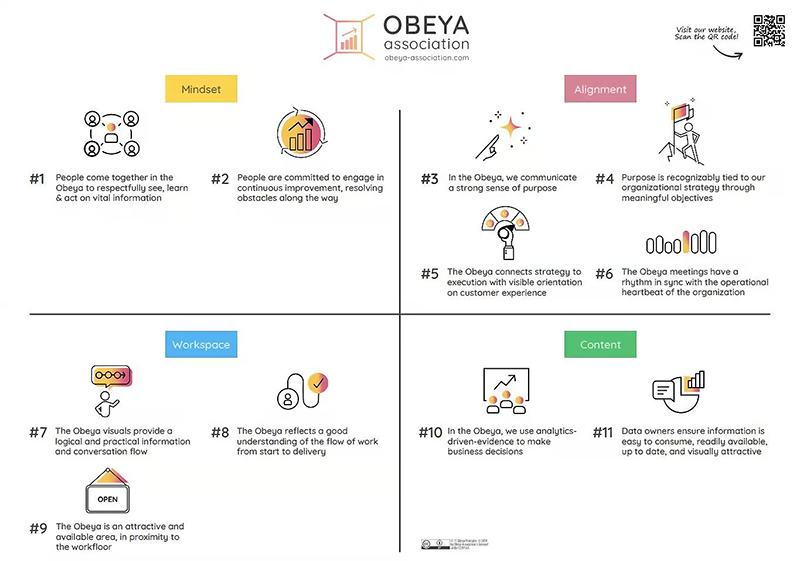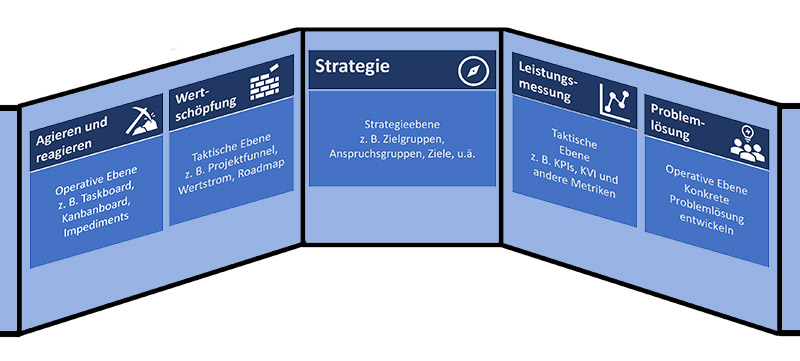Obeya: The visualisation of relevant information
Visualisation as a core element in Obeya and for working in teams
A message from Alex appears in the team chat: “Hello Thomas, do you have a minute? I’ve got an issue I’d like to get another opinion on. I had the feeling again today in the Daily that we’re missing something.”
Thomas knew Alex from two completed projects in which they had worked together. Since then, they had always exchanged ideas when they were stuck on a topic. Thomas knew that Alex was currently working on a project with several teams that was not easy in terms of subject matter and was strategically very important for the company.
“Call me when you have time,” Thomas replies and takes a deep sip from his coffee cup. Less than three minutes later, Alex rings through.
“Hello Thomas,” Alex grins into the camera. “How many cups of coffee have you had today? Sorry to interrupt, but I’m chewing on something and I realised it again this morning. I’d love to hear your opinion.”
“I can never have enough coffee,” jokes Thomas. “What’s it about?”
Alex pauses for a moment before answering: “The usual topic: we don’t have enough overview of the relevant information. The Jira board here, the wiki there and then a file repository with lots of individual documents. Everything is distributed. The sprint goal is in the wiki, the tickets disappear into the board, and once again nobody has our retro results on their screen. And then there’s the management, which I also have to involve again and again when it comes to strategic decisions and which meets with us once a week. We have to painstakingly gather and prepare all the relevant information every time. That simply takes too much time and I have the feeling that we simply overlook a lot of things. You said something about visualisation a few weeks ago. Do you think that could help us?”
Thomas thinks for a moment. He had come across something a few weeks ago that he really liked and had told his colleagues about it. “Yes, exactly – it could actually be a good fit here,” says Thomas thoughtfully. “Obeya would probably be a good place to start.”
What is Obeya?
Obeya is a Japanese word. It means something like “large space”. The word became known through the Toyota production system, which relies heavily on visualisation. Among other things, the Toyota Prius was developed within 7 months using this approach. Visualisation is one of the core elements of Obeya. Don’t worry, visualisation does not mean becoming an artist, but rather making information visible.
“Obeya is a system, a concept, a philosophy defined by a set of ideas (“principles”). Organisations use these 11 Obeya principles in their pursuit of inclusive and sustainable decision-making.”1
Figure 1: Obeya principles2
Put simply, Obeya is a visual information and decision-making forum. It is based on the idea that by visualising all relevant information and bringing all relevant people together, obstacles can be removed and better decisions can be made. As such, Obeya is closely linked to Kaizen, the pursuit of continuous improvement.
The organisation of information
What information do we need to know if what we are doing is really contributing to success?
Many organisations are grappling with this question. Unsurprisingly, consolidating relevant information in one central place is a good idea to recognise connections. The arrangement of the elements often follows Demming’s PDCA cycle. It is important that the visualisations provide a logical and practical flow of information and communication that reflects the workflow from start to delivery (across the entire value stream).
Tim Wiegel provides an interesting design proposal with a reference model consisting of the following five elements:
- act and react
- value creation
- strategy
- performance measurement
- problem solving
Figure 2: Obeya reference model according to Tim Wiegel3
The “strategy” section contains all strategy-relevant information, such as common goals, target groups, the description of stakeholder needs, etc.
The “value creation” area contains information at the tactical level, such as a portfolio funnel, value stream descriptions or roadmaps.
The “act and react” area contains information that relates to active day-to-day business and requires joint decisions. Typically, obstacles are collected here, progress towards solutions is made transparent and tasks are visualised on a task board, Kanban board or Kamishibai board4.
The counterpart on the other side of the value chain is the “performance measurement” area with metrics such as velocity, throughput times, but also business value or other evidence-based key figures.
The problem-solving zone is the area in which operational problems and challenges are processed and solved.
For Obeya to be fully effective, it must be easily accessible to all those involved. This sounds trivial at first, but – as with all tools – it should not be underestimated. The greater the effort involved in using a tool, the greater the hurdle to using it on a permanent basis.
In addition, Obeya – in the spirit of avoiding non-value-adding work (also known as muda) – wants to avoid long paths so that users can concentrate on the essentials. It is therefore advisable to ensure that the data is up to date and that the processed information is easy to understand.
Alignment with the heartbeat of the organisation
The common goal is at the centre of the strategy-relevant information and therefore of Obeya. It defines the direction of the activities, which are linked to the corporate strategy through meaningful milestones and made visible through visualisation in the “big picture”. The central principle is the linking of the various levels from strategy to tactics to operational implementation. The starting point is the result from the customer’s perspective, i.e. a consistent alignment of the processes from right to left5 (along the value stream).
This is combined with cadences in which the relevant players come together. The cadences form a fixed rhythm in which the fields of action of the respective levels of consideration come into focus. While the operational working level, for example, is part of the daily exchange, the tactical level is placed at the centre of the exchange once a week and the strategic level once a month as a key task. This makes it very easy to visually link the operational, tactical and strategic levels and make them transparent. Connections and effects are thus recognised more quickly. The rhythm is based on the heartbeat of the organisation, the environment and the needs of those involved. We are already familiar with something similar from various agile frameworks such as Kanban and Scrum in the form of dailies, retrospectives, etc.
Conclusion
“Obeya is a system, a concept, a philosophy defined by a set of ideas (“principles”). Organisations use these 11 Obeya principles in their pursuit of inclusive and sustainable decision-making.” Or simply put: Obeya is an information and decision-making forum, a large physical or digital space for visualising information and making decisions together.
There are fixed locations for specific information in the large space, so that all participants know immediately where to find which information at any time. Important information is visualised,
- this increases transparency,
- makes it easier to recognise connections,
- supports collaboration across team boundaries and
- promotes the quality of joint decision-making.
Due to its basic structure, Obeya is suitable for teams as well as for scaling across teams or organisational units. Scaling across strategic, tactical and operational levels can also be easily visualised with Obeya. The visualisation even helps to make the bridges and connections between different levels of an organisation visible.
Practice shows that you can use Obeya as a framework in its own right or to support individual Scrum teams, in conjunction with Kanban, in the SAFe context at the level of a release or solution train or even with the flight level approach. The challenge for organisations is often to embrace the transparency and the very kaizen mindset of collaboration. In my opinion, however, it is worth the effort to create a large space with transparent information, as obstacles can actually be recognised early on and better decisions can be made together.
Extra bonus
Here you will find 3 additional questions about Obeya answered by Thomas Michl (please press the plus buttons):
How can data redundancy be avoided if information is already collected in different places?
Thomas Michl: There is a responsible role for this: the Obeya Builder(s). The respective role holder is responsible for ensuring that the data in the Obeya space is maintained and up-to-date and that it is the relevant data. The role does not necessarily have to be performed by one person; it is conceivable that different people are responsible for different areas. Through constant dialogue between all those involved, the Obeya room becomes the most important place for information. Don’t forget, the primary goal of the Obeya is to make good decisions and to bring the relevant information and people together in one place.
Who decides what information is relevant and belongs in the large room?
Thomas Michl: Ideally, the decision-makers who gather in the Obeya room. The exchange processes and dialogues are then geared towards clarifying what information is necessary for the work to succeed. Constant reflection (in the sense of Kaizen) is a central component of Obeya and also includes the question of what is “done” for whom and with what goal and what is needed for it to succeed. Visualisation in the Obeya space is the tool for making progress, problems/obstacles and findings visible.
How useful is it to transfer individual elements of a Japanese culture or philosophy to other economic systems?
Thomas Michl: Obeya is a fine example of how European and Far Eastern ideas can work together. Historically, Obeya is the result of such a mixture. The result of a combination of the tradition of the Japanese tea ceremony, which is about the art of good conversation, and the idea of the empirical-scientific way of working, which was strongly influenced by Western thinkers. The Toyota Production System is characterised by ideas that Deming once brought to Japan and combined with Japanese thinking traditions. Kanban, also closely associated with Toyota, was originally inspired by the idea of the American supermarket. And friends of the Stoa (an ancient school of philosophy) will discover many parallels on closer inspection, for example with the topic of kaizen. Ideas have always inspired each other. And many ideas are not foreign to us. Thinking like a craftsman (in categories of expediency), focussing on the reasons for success and getting better and better at what we do through reflection are elements that are not typically Japanese. In other words, good ideas have always travelled. From east to west, from north to south and vice versa.
Notes:
Would you like to exchange ideas? There is a German-language LinkedIn group and a monthly exchange on the topic of visual organisation by Thomas Michl, Dieter Stasser and Olaf Bublitz.
[1] What is an Obeya?
[2] Obeya Principles?
[3] Tim Wiegel: Leading with Obeya
[4] see Kamishibai and Kanban for (too) interdisciplinary teams
[5] see Resilience and agility with the right focus: Thinking from right to left
Do you already know Toms Gedankenblog? For many years, Thomas Michl has been reflecting different perspectives on agility, lean management, Kanban, etc. there. And his new thought pieces are also very popular!
If you like the article or would like to discuss it, please feel free to share it in your network.
Thomas Michl has published more articles on the t2informatik Blog, including

Thomas Michl
Thomas Michl holds a degree in public administration and an MBA. He worked in the public sector for ten years before joining borisgloger consulting GmbH in 2018 and then Exxeta AG. Today, the passionate agilist works for FourEnergy GmbH as a Senior Business Consultant.
Thomas Michl is one of the founding members of the Agile Administration Forum and a board member of the supporting organisation. The Agile Administration Forum is run on a voluntary basis and has set itself the goal of bringing the idea of the Agile Manifesto to public administration by providing a platform for dialogue and peer-to-peer advice.




